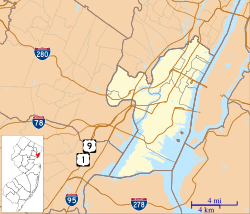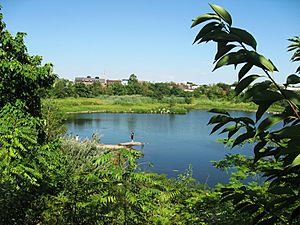Hackensack Water Company Complex facts for kids
|
Hackensack Water Company Complex
|
|

Red tower
|
|
| Location | 4100 Park Avenue, Weehawken, New Jersey |
|---|---|
| Area | 7.7 acres (3.1 ha) |
| Built | 1883 |
| Architect | Withers, Frederick C. |
| NRHP reference No. | 80002491 |
Quick facts for kids Significant dates |
|
| Added to NRHP | January 3, 1980 |
The Hackensack Water Company Complex is a group of old buildings in Weehawken, New Jersey. These buildings are important because they are listed on the U.S. National Register of Historic Places. The Hackensack Water Company, which later became part of Suez North America, was in charge of providing water to people in northeastern New Jersey. They did this from the 1870s to the 1970s.
At first, the company supplied water to the city of Hackensack and the towns of North Hudson. Their main offices and facilities were originally in Hackensack, in Bergen County. Later, under the leadership of Robert W. de Forest, who managed the company for 46 years starting in 1881, the company built new facilities. They also moved their main office to Weehawken in Hudson County. Their new offices were inside a brick water tower, which is part of the complex you can see today.
Contents
Weehawken Water Tower
The most famous part of the complex is the red brick Weehawken Water Tower. It was built in 1883 on what is now Park Avenue, right on the edge of Union City. A famous architect named Frederick Clarke Withers designed it. He based its look on the Palazzo Vecchio in Florence, Italy. The tower stands 175 feet tall and is 300 feet above sea level when measured from the Hudson River.
How the Tower Worked
The tower was connected to Reservoir No.1, which was located on top of the Hudson Palisades. Water was pumped to this reservoir from the Hackensack River, about 14 miles away. While the reservoir could provide enough water pressure for people in Hoboken (which is close to sea level), it wasn't enough for customers living high up on the Palisades.
The tower had two main jobs. First, it served as the local office for the Hackensack Water Company. Second, it held a huge tank that could store up to 165,000 gallons of clean drinking water. This water was kept under pressure for homes, businesses, and for fighting fires. When it opened on September 29, 1883, it was a big deal. Experts praised Withers for his clever design. The "Red Tower" is even marked on official maps for ships. It helps them know they are getting close to New York Harbor when sailing south on the Hudson River.
Saving and Restoring the Tower
The Weehawken Water Tower was added to the National Register of Historic Places in 1980. This important listing helped save it from being torn down. After that, the tower was kept in good shape. In 1981, a real-estate company bought the complex. Sadly, the gatehouse and reservoir were removed to build a supermarket and parking lot. But the tower itself was saved and maintained.
In 2000, the town of Weehawken took over the property. They started a project to restore the Water Tower Park. In September 2004, a company finished eight months of work on the outside of the tower. They replaced the roof's slate, fixed the stonework at the bottom, and put in new windows. Inside, new steel supports and wood floors were added. Space was even left for a future elevator and fire escape.
In October 2005, a public plaza park was created at the base of the tower. The inside of the tower was also restored in the late 2000s. In 2010, for the town's 150th anniversary, the inside brickwork was cleaned while keeping its historic look. In 2014, Mayor Richard Turner allowed the tower to be used for a reading series. This was the first time the restored tower had been used for an event in over 100 years.
Hackensack Reservoir No. 2 - Reservoir Park
Hackensack Reservoir No. 2 was another important part of the water company's system in Weehawken. It was later owned by United Water. This site is a bit more than 14 acres and is the largest undeveloped piece of land in North Hudson. It is located in Weehawken Heights. The reservoir is bordered by Highpoint Avenue, Gregory Avenue, 20th Street, and Palisade Avenue. The last two streets form the border with nearby Union City. This reservoir was built when the area was growing very quickly in the late 1800s.
History of the Reservoir
A historical marker at the site tells us more:
Construction of the Hackensack Water Company's Reservoir No. 2 at the southern end of the township began around 1893. It was built to serve the Heights section of Weehawken, and the surrounding areas of Union City and West Hoboken. The reservoir was dug out of glacial trap rock. It started working in 1896 and could hold 69 million gallons of water. The company also put in a covered water tank in 1893, which is now in Gregory Park.
Becoming a Park
In early 2011, United Water announced they wanted to sell most of the property. They planned to keep 4.2 acres to build an underground water storage tank. This tank would help improve water pressure and was estimated to cost a lot of money. The Trust for Public Land, a group that helps protect land, helped delay the sale of the reservoir until the end of that year.
In 2010, the town of Weehawken began working to buy the land. The New Jersey Department of Environmental Protection gave the town a $2 million grant to help. They also received a large, low-interest loan. Weehawken and Union City decided to invest money to turn the grounds into a park for people to enjoy quietly. They also agreed to share the yearly costs of keeping up the property. The sale was completed in December 2011. The park officially opened to the public in 2015.
Jersey City Reservoir No. 3
While not part of the Hackensack Water Company's original system, another reservoir on top of the Hudson Palisades is Jersey City Reservoir No. 3. This one was also built in the late 1800s in Jersey City Heights, Jersey City. It was closed to the public in the 1970s. Its use as a city water source ended in 1992. Since 2007, this open reservoir has been kept as a wildlife area for public use, right next to Pershing Field. Another nearby reservoir, Reservoir #1, was located on either side of Summit Avenue, but it has since been taken down.
See also
 In Spanish: Complejo de la Compañía de Agua de Hackensack para niños
In Spanish: Complejo de la Compañía de Agua de Hackensack para niños





